Analysis of Drawings on Representations of COVID-19 among Senior High School Students: Case of the Dakhla-Oued Eddahab Region, Morocco
Abstract
1. Introduction
- How is COVID-19 represented in the senior high school students’ drawings?
- What is the predominant representation of these various representations?
- How do the drawings constructed by the senior high school students relate to the scientific image of COVID-19?
2. Literature Review
- (a)
- Representations that reduce COVID-19 to preventive measures. In this category of drawings, students’ representations may have a medical or a social meaning, so the researchers, therefore, decided that this category includes all drawings that indicate medical and social dimensions. It involved students’ drawings that express COVID-19 by preventive measures, behaviors related to virus transmission, and all recommendations or restrictions to limit social interactions with others: forbidden to greet others by shaking hands, face mask/put on the face mask, distancing, using sanitizer/disinfectant, handwashing, quarantine at home, intervention of doctors or medical staff, cooperation, etc.
- (b)
- Animistic and anthropomorphic representations that give COVID-19 a dynamic “hero” quality: this representation is related to a coronavirus hybrid theme—it gathers all the drawings when students gives anthropomorphic features and/or added a crown to their, otherwise realistic, drawings of the virus [3], and it includes illustrations as cartoons: face forms, who carries hands, fingers, mouth, eyes, nose, teeth, ears, with limbs (tentacles, legs, and arms), or expressions of a challenge.
- (c)
- Representations that link COVID-19 to fear and death: this representation is related to the psychological theme which involved items referring to psychological functions, such as emotions, by drawings expressing unhappiness/sadness/crying/colors, or drawings and expressions that are signifiers of danger, virus mutation, and virus polymorphism, drawings translating COVID-19 into death and the end of the world, the threat of life on the earth, and pollution.
- (d)
- Representations related to confusing COVID-19 with bacteria and living cells: this representation is related to coronavirus theme in its part as mythical/symbolic—it gathers all the drawings when students’ drawings ascribed animal-like or microscopic organisms’ characteristics to coronavirus, such as drawing a cell bounded by a membrane/cells with nuclei, the form of fragmented cells, and multiplying cells.
- (e)
- Scientific representations: this representation is related to coronavirus theme in its realistic part, and it has been considered when students’ drawings illustrated morphological characteristics of coronavirus, as commonly depicted in the media, i.e., its spherical scheme and/or spikes, circular shapes that have particles on the surface, and circular designs that bear thorns.
3. Materials and Methods
3.1. Population and Study Sample
3.2. Ethical Research Practice and Data Collection
3.3. Data Collection and Analyses
3.3.1. Data Collection
3.3.2. Coding of Data
3.3.3. Statistical Analysis of Data
4. Results
4.1. Descriptions of Students’ Drawings and Identification of Their Representations
4.2. Grouping of the Different Student Drawings According to the Predefined Representations
4.2.1. Representations Related to Preventive Measures
4.2.2. Animistic and Anthropomorphic Representations That Give COVID-19 a Dynamic Character or as “Hero”
4.2.3. Representations Related to Fear and Death “The Thanatophobia”
4.2.4. Confusion of COVID-19 with Bacteria and Living Cells
4.2.5. Scientific Representations
4.3. Student’s Representations According to Gender and to Age
5. Discussion
6. Limitations and Future Research
7. Conclusions
Author Contributions
Funding
Institutional Review Board Statement
Informed Consent Statement
Data Availability Statement
Conflicts of Interest
References
- Sohrabi, C.; Alsafi, Z.; O’Neill, N.; Khan, M.; Kerwan, A.; Al-Jabir, A.; Iosifidis, C.; Agha, R. World Health Organization declares global emergency: A review of the 2019 novel coronavirus (COVID-19). Int. J. Surg. 2020, 76, 71–76. [Google Scholar] [CrossRef]
- Jee, B.D.; Uttal, D.H.; Spiegel, A.; Diamond, J. Expert-novice differences in mental models of viruses, vaccines, and the causes of infectious disease. Public Underst. Sci. 2015, 24, 241–256. [Google Scholar] [CrossRef]
- Bonoti, F.; Christidou, V.; Papadopoulou, P. Children’s conceptions of coronavirus. Public Underst. Sci. 2022, 31, 35–52. [Google Scholar] [CrossRef]
- Benjamin, F.; Jean, K.; Antoine, R.; Prou, M.; Millien, M.; Balthazard-Accou, K.; Emmanuel, E. COVID-19: Perception of the Pandemic and the Importance of Barrier Measures by the Fruit and Vegetable Sellers of Port-Au-Prince. Eur. Sci. J. 2021, 17, 165. [Google Scholar] [CrossRef]
- Wang, Y.; Pan, B.; Liu, Y.; Wilson, A.; Ou, J.; Chen, R. Health care and mental health challenges for transgender individuals during the COVID-19 pandemic. Lancet Diabetes Endocrinol. 2020, 8, 564–565. [Google Scholar] [CrossRef]
- Ma, Z.; Zhao, J.; Li, Y.; Chen, D.; Wang, T.; Zhang, Z.; Chen, Z.; Yu, Q.; Jiang, J.; Fan, F.; et al. Mental health problems and correlates among 746 217 college students during the coronavirus disease 2019 outbreak in China. Epidemiol. Psychiatr. Sci. 2020, 29, E181. [Google Scholar] [CrossRef] [PubMed]
- Mudenda, S.; Mukosha, M.; Mwila, C.; Saleem, Z.; Kalungia, A.; Munkombwe, D.; Daka, V.; Witika, B.; Kampamba, M.; Hikaambo, C.; et al. Impact of the coronavirus disease on the mental health and physical activity of pharmacy students at the University of Zambia: A cross-sectional study. Int. J. Basic Clin. Pharmacol. 2021, 10, 324–332. [Google Scholar] [CrossRef]
- Moroccan Ministry of Health. COVID-19 Epidemic in Morocco, Progress Report as of March 31, 2020. Available online: https://www.sante.gov.ma/Publications/Bullten_pidmiologique/COVID19%20Rapport%20d%E2%80%99%C3%A9tape%20au%2031%20mars%202020.pdf (accessed on 25 May 2022).
- Merzouki, M.; Bentahir, M.; Chigr, F.; Najimi, M.; Gala, J. The Modeling of the Capacity of the Moroccan Healthcare System in the Context of COVID-19: The Relevance of the Logistic Approach. In Handbook of Research on Pathophysiology and Strategies for the Management of COVID-19, 2nd ed.; El Hiba, O., Radhakrishnan, J., Balzano, T., Isbaine, F., Eds.; IGI Global: Hershey, PA, USA, 2022; pp. 17–26. [Google Scholar] [CrossRef]
- Zou, W.; Tang, L. What do we believe in? Rumors and processing strategies during the COVID-19 outbreak in China. Public Underst. Sci. 2021, 30, 153–168. [Google Scholar] [CrossRef] [PubMed]
- Urbina-Garcia, A. Young Children’s Mental Health: Impact of Social Isolation during the COVID-19 Lockdown and Effective Strategies. Diálogos. Sobre Educ. 2020, 12, 22. [Google Scholar] [CrossRef]
- Deng, J.; Zhou, F.; Hou, W.; Silver, Z.; Wong, C.Y.; Chang, O.; Drakos, A.; Zuo, Q.K.; Huang, E. The prevalence of depressive symptoms, anxiety symptoms and sleep disturbance in higher education students during the COVID-19 pandemic: A systematic review and meta-analysis. Psychiatry Res. 2021, 301, 113863. [Google Scholar] [CrossRef]
- Carson, D.K.; Gravley, J.E.; Council, J.R. Children’s prehospitalization conceptions of illness, cognitive development, and personal adjustment. Child Health Care 1992, 21, 103–110. [Google Scholar] [CrossRef]
- Idoiaga, N.; Berasategi, N.; Eiguren, A.; Picaza, M. Exploring Children’s Social and Emotional Representations of the COVID-19 Pandemic. Front. Psychol. 2020, 11, 1952. [Google Scholar] [CrossRef]
- Moss-Morris, R.; Paterson, J. Understanding children’s concepts of health and illness: Implications for developmental therapists. Phys. Occup. Ther. Pediatr. 1995, 14, 95–108. [Google Scholar] [CrossRef]
- Simeonsson, R.J.; Buckley, L.; Monson, L. Conceptions of illness causality in hospitalized children. In Readings in Pediatric Psychology; Roberts, M.C., Koocher, G.P., Routh, D.K., Willis, D.J., Eds.; Springer: New York, NY, USA, 1993; pp. 173–180. [Google Scholar]
- Moscovici, S. Social representations. In Explorations in Social Psychology; Duveen, G., Ed.; Polity Press: Cambridge, UK, 2000. [Google Scholar]
- Ring, K. Supporting young children drawing: Developing a role. IJETA 2006, 2, 195–209. [Google Scholar] [CrossRef] [PubMed]
- Bekhit, N.; Thomas, G.; Jolley, R. The use of drawing for psychological assessment in Britain: Survey findings. Psychol. Psychother. 2005, 78, 205–217. [Google Scholar] [CrossRef]
- Mouratidi, P.S.; Bonoti, F.; Leondari, A. Children’s perceptions of illness and health: An analysis of drawings. Health Educ. J. 2016, 75, 434–447. [Google Scholar] [CrossRef]
- Piko, B.F.; Bak, J. Children’s perceptions of health and illness: Images and lay concepts in preadolescence. Health Educ. Res. 2006, 21, 643–653. [Google Scholar] [CrossRef] [PubMed]
- Zaloudikova, I. Children’s conceptions of health, illness, death and anatomy of the human body. In School and Health 21. Health Education: Contexts and Inspiration, 1st ed.; Řehulka, E., Ed.; Masarykova Univerzita: Brno, Czech Republic, 2010; pp. 123–140. [Google Scholar]
- King, L.D. Doing Their Share to Save the Planet: Children and Environmental Crisis; Rulgers University Press: New Brunswick, NJ, USA, 1995. [Google Scholar]
- Brooks, M. What Vygotsky Can Teach Us about Drawing. Art Early Child. 2009, 1, 1–13. Available online: https://www.artinearlychildhood.org/journal/38659-2 (accessed on 22 July 2022).
- Lewis, D.; Greene, J. Your Child’s Drawings…Their Hidden Meaning; Hutchinson: London, UK, 1983. [Google Scholar]
- Chambers, D.W. Stereotypic images of the scientist: The draw-a-scientist test. Sci. Educ. 1983, 67, 255–265. [Google Scholar] [CrossRef]
- Crook, C. Knowledge and appearance. In Visual Order: The Nature and Development of Pictorial Representation; Freeman, N.H., Cox, M.V., Eds.; Cambridge University Press: Cambridge, UK, 1985; pp. 248–265. [Google Scholar]
- Farokhi, M.; Hashemi, M. The analysis of children’s drawings: Social emotional, physical, and psychological aspects. Procedia Soc Behav Sci. 2011, 30, 2219–2224. [Google Scholar] [CrossRef]
- Thomas, G.V.; Silk, A.M.J. An Introduction to the Psychology of Children’s Drawings; New York University Press: New York, NY, USA, 1990. [Google Scholar]
- Billig, M. Ideology and Opinions: Studies in Rhetorical Psychology; Sage: London, UK, 1991. [Google Scholar]
- Moscovici, S. Why a theory of social representations? In Representations of the Social; Deaux, K., Philogene, G., Eds.; Blackwell: Oxford, UK, 2001; pp. 8–35. [Google Scholar]
- Doise, W.; Clémence, A.; Lorenzi-Cioldi, F. Représentations Sociales et Analyses de Données; Presses Universitaires de Grenoble: Grenoble, France, 1992. [Google Scholar]
- Garniez, C.; Sauvé, L. Apport de la théorie des représentations sociales à l’éducation relative à l’environnement–Conditions pour un design de recherche. Éduc. Relat. Environ. Regards-Rech.-Réflex. 1999, 1, 65–77. Available online: https://archipel.uqam.ca/7100/ (accessed on 22 July 2022).
- Jodelet, D. Les Représentations Sociales: Un Domnaine en Expansion; Presses Universitaires de France: Paris, France, 1989; pp. 31–61. [Google Scholar]
- Sauvé, L.; Machabée, L. La représentation: Point focal de l’apprentissage. Éduc. Relat. Environ. Regards-Rech.-Réflex. 2000, 2, 183–194. Available online: https://archipel.uqam.ca/7216/ (accessed on 22 July 2022). [CrossRef]
- Hadjichambis, A.C.; Paraskeva-Hadjichambi, D.; Ioannou, H.; Georgiou, Y.; Manoli, C.C. Integrating Sustainable Consumption into Environmental Education: A Case Study on Environmental Representations, Decision Making and Intention to Act. Int. J. Environ. Sci. Educ. 2015, 10, 67–86. [Google Scholar] [CrossRef]
- Shepardson, D.P.; Wee, B.; Priddy, M.; Harbor, J. Students’ mental models of the environment. J. Res. Sci. Teach. 2007, 44, 327–348. [Google Scholar] [CrossRef]
- Lee, K. The green purchase behavior of Hong Kong young consumers: The role of peer influence, local environmental involvement, and concrete environmental knowledge. J. Int. Consum. Mark. 2010, 23, 21–44. [Google Scholar] [CrossRef]
- Astolfi, J.P.; Darot, E.; Ginsburger-Vogel, Y.; Toussaint, J. Mots-clés de la Didactique des Sciences, 2nd ed.; De Boeck Université: Bruxelles, Belgium, 2008. [Google Scholar]
- Bachelard, G. La Formation de l’esprit Scientifique; VRIN: Paris, France, 1938. [Google Scholar]
- Giordan, A.; Vecchi, G.D. Les origines du savoir. Des conceptions des apprenants aux concepts scientifiques. Rev. Française Pédagogie 1987, 84, 95–97. [Google Scholar]
- Osborne, J.; Collins, S. Pupils’ Views of the Role and Value of the Science Curriculum: A Focus-group Study. Int. J. Spec. Educ. 2011, 23, 441–467. [Google Scholar] [CrossRef]
- Jidesjö, A.; Oscarsson, M.; Karlsson, K.G.; Strömdahl, H. Science for all or Science for some: What Swedish Students Want to Learn about in Secondary Science and Technology and Their Opinions on Science Lessons. NorDiNa 2009, 5, 213–229. [Google Scholar] [CrossRef]
- Lavonen, J.; Juuti, K.; Uitto, A.; Meisalo, V.; Byman, R. Attractiveness of Science Education in the Finnish Comprehensive School. In Research Findings on Young People’s Perceptions of Technology and Science Education: Mirror Results and Good Practice; Technology Industries of Finland: Helsinki, Finland, 2005; pp. 5–30. [Google Scholar]
- Cipková, E.; Karolcık, S.; Dudová, N.; Nagyová, S. What is the Students’ Interest in Biology after the Biology Curriculum Modification? Curric. J. 2017, 29, 370–386. [Google Scholar] [CrossRef]
- Pellegrini, G. Adolescentitrascienza, tecnologia e futuro: I risultatidell’Indagine Observa-PRISTEM Bocconi 2017. Lett. Pristem. 2018, 103, 4–10. [Google Scholar] [CrossRef]
- Franzolin, F.; Carvalho, G.S.; Santana, C.M.B.; Calegari, A.d.S.; Almeida, E.A.E.d.; Soares, J.P.R.; Jorge, J.; Neves, F.D.d.; Lemos, E.R.S. Students’ Interests in Biodiversity: Links with Health and Sustainability. Sustainability 2021, 13, 13767. [Google Scholar] [CrossRef]
- Santos Gouw, A.M. As Opiniões, Interesses e Atitudes dos JovensBrasileirosFrente à Ciência: UmaAvaliação de ÂmbitoNacional. Ph.D. Thesis, University of São Paulo, São Paulo, Brazil, 2013. [Google Scholar]
- Matthews, P. The Relevance of Science Education in Ireland; Royal Irish Academy: Dublin, Ireland, 2007. [Google Scholar]
- Jenkins, E.W.; Nelson, N.W. Important but not for me: Students’ Attitudes towards Secondary School Science in England. Res. Sci. Technol. 2005, 23, 41–57. [Google Scholar] [CrossRef]
- Jenkins, E.W.; Pell, R.G. The Relevance of Science Education Project (ROSE) in England: A Summary of Findings; Centre for Studies in Science and Mathematics Education, University of Leeds: Leeds, UK, 2006. [Google Scholar]
- Tolentino Neto, L.C.B. OsInteresses e Posturas de Jovens Alunos Frenteàs Ciências: Resultados do Projeto Rose Aplicado no Brasil. Ph.D. Thesis, University of São Paulo, São Paulo, Brazil, 2008. [Google Scholar]
- Uitto, A.; Juuti, K.; Lavonen, J.; Meisalo, V. Students’ Interest in Biology and Their Out-of-school Experiences. J. Biol. Educ. 2006, 40, 124–129. [Google Scholar] [CrossRef]
- Abdelrahman, M. Personality Traits, Risk Perception, and Protective Behaviors of Arab Residents of Qatar during the COVID-19 Pandemic. Int. J. Ment. Health Addict. 2020, 20, 237–248. [Google Scholar] [CrossRef] [PubMed]
- Rana, I.A.; Bhatti, S.S.; Aslam, A.B.; Jamshed, A.; Ahmad, J.; Shah, A.A. COVID-19 risk perception and coping mechanisms: Does gender make a difference? Int. J. Disaster Risk Reduct. 2021, 55, 102096. [Google Scholar] [CrossRef]
- Albaqawi, H.M.; Alquwez, N.; Balay-Odao, E.; Bajet, J.B.; Alabdulaziz, H.; Alsolami, F.; Tumala, R.B.; Alsharari, A.F.; Tork, H.M.M.; Felemban, E.M.; et al. Nursing Students’ Perceptions, Knowledge, and Preventive Behaviors Toward COVID-19: A Multi-University Study. Front. Public Health 2020, 23, 8. [Google Scholar] [CrossRef]
- Assante, G.M.; Candel, O.S. Students’ views on the COVID-19 pandemic: Attitudes, representations, and coping mechanisms. Postmod. Open 2020, 11, 347–365. [Google Scholar] [CrossRef]
- Christidou, V.; Papadopoulou, P.; Bonoti, F. Greek children’s views of COVID-19 preventive practices. Mediterr. J. Educ. 2021, 1, 1–7. [Google Scholar]
- Bray, L.; Blake, L.; Protheroe, J.; Nafria, B.; de Avila, M.A.G.; Ångström-Brännström, C.; Forsner, M.; Campbell, S.; Ford, K.; Rullander, A.C.; et al. Children’s pictures of COVID-19 and measures to mitigate its spread: An international qualitative study. Health Educ. J. 2021, 80, 811–832. [Google Scholar] [CrossRef]
- Koller, D.; Nicholas, D.; Gearing, R.; Kalfa, O. Paediatric pandemic planning: Children’s perspectives and recommendations. Health Soc. Community 2010, 18, 369–377. [Google Scholar] [CrossRef]
- Matovu, J.K.B.; Kabwama, S.N.; Ssekamatte, T.; Ssenkusu, J.; Wanyenze, R.K. COVID 19 Awareness, Adoption of COVID 19 Preventive Measures, and Effects of COVID 19 lockdown among Adolescent Boys and Young Men in Kampala, Uganda. J. Community Health 2021, 46, 842–853. [Google Scholar] [CrossRef] [PubMed]
- Asiamah, N.; Opuni, F.F.; Mends-Brew, E.; Mensah, S.W.; Mensah, H.K.; Quansah, F. Short-term changes in behaviors resulting from COVID-19-related social isolation and their infuences on mental health in Ghana. Community Ment. Health J. 2020, 57, 79–92. [Google Scholar] [CrossRef]
- Nyashanu, M.; Ikhile, D.; Thamary, K.; Chireshe, R. The impact of COVID-19 lockdown in a developing country: Narratives of self-employed women in Ndola, Zambia. Health Care Women Int. 2020, 41, 1370–1383. [Google Scholar] [CrossRef]
- Garcia de Avila, M.A.; Hamamoto Filho, P.T.; Jacob, F.L.S.; Alcantara, L.R.S.; Berghammer, M.; Jenholt Nolbris, M.; Olaya-Contreras, P.; Nilsson, S. Children’s anxiety and factors related to the COVID-19 pandemic: An exploratory study using the Children’s Anxiety Questionnaire and the Numerical Rating Scale. Int. J. Environ. Res. Public Health 2020, 17, 5757. [Google Scholar] [CrossRef] [PubMed]
- Brooks, S.K.; Smith, L.E.; Webster, R.K.; Weston, D.; Woodland, L.; Hall, I.; Rubin, G.J. The impact of unplanned school closure on children’s social contact: Rapid evidence review. Eurosurveillance 2020, 25, 2000188. [Google Scholar] [CrossRef]
- Loades, M.E.; Chatburn, E.; Higson-Sweeney, N.; Reynolds, S.; Shafran, R.; Brigden, A.; Linney, C.; McManus, M.N.; Borwick, C.; Crawley, E. Rapid systematic review, the impact of social isolation and loneliness on the mental health of children and adolescents in the context of COVID-19. J. Am. Acad. Child Adolesc. Psychiatry 2020, 59, 1218–1239. [Google Scholar] [CrossRef]
- Nearchou, F.; Flinn, C.; Niland, R.; Subramaniam, S.S.; Hennessy, E. Exploring the impact of COVID-19 on mental health outcomes in children and adolescents: A systematic review. Int. J. Environ. Res. Public. Health 2020, 17, 8479. [Google Scholar] [CrossRef]
- Patrick, S.; Henkhaus, L.; Zickafoose, J.; Lovell, K.; Halvorson, A.; Loch, S.; Letterie, M.; Davis, M.M. Well-being of parents and children during the COVID-19 pandemic: A national survey. Pediatrics 2020, 146, e2020016824. [Google Scholar] [CrossRef] [PubMed]
- Dunton, G.F.; Do, B.; Wang, S.D. Early effects of the COVID-19 pandemic on physical activity and sedentary behavior in children living in the U.S. BMC Public Health 2020, 20, 1351. [Google Scholar] [CrossRef]
- Xiang, M.; Zhang, Z.; Kuwahara, K. Impact of COVID-19 pandemic on children and adolescents’ lifestyle behavior larger than expected. Prog. Cardiovasc. Dis. 2020, 63, 531–532. [Google Scholar] [CrossRef] [PubMed]
- CDC (Centers for Disease Control and Prevention). Crisis and Emergency Risk Communication: Pandemic Influenza. 2007. Available online: https://stacks.cdc.gov/view/cdc/7037 (accessed on 27 May 2022).
- Rowland, A.; Cook, D.L. Unlocking children’s voices during SARS-CoV-2 coronavirus (COVID-19) pandemic lockdown. Arch. Dis. Child. Lond. 2020, 106, e13. [Google Scholar] [CrossRef]
- Martinerie, L.; Bernoux, D.; Giovannini-Chami, L.; Fabre, A. Children’s Drawings of Coronavirus. Pediatrics 2021, 148, e2020047621. [Google Scholar] [CrossRef]
- Manches, A.; Ainsworth, S. Learning About Viruses: Representing COVID-19. Front. Educ. 2022, 6, 736744. [Google Scholar] [CrossRef]
- Byrne, J. Models of Micro-Organisms: Children’s Knowledge and Understanding of Micro-organisms from 7 to 14 Years Old. Int. J. Sci. Educ. 2011, 33, 1927–1961. [Google Scholar] [CrossRef]
- Jones, M.G.; Rua, M.J. Conceptions of Germs: Expert to Novice Understandings of Microorganisms. Electron. J. Sci. Educ. 2006, 10, 1–40. [Google Scholar]
- Bracko, M.; Simon, U.K. Virus-related Knowledge in COVID-19 Times-Results from two Cross-sectional Studies in Austria and Implications for School. Int. J. Biol. Sci. 2022, 18, 1627–1650. [Google Scholar] [CrossRef]
- Bhagat, K.; Howard, D.E.; Aldoory, L. The relationship between health literacy and health conceptualizations: An exploratory study of elementary school-aged children. Health Commun. 2018, 33, 131–138. [Google Scholar] [CrossRef]
- Stein, A.; Dalton, L.; Rapa, E.; Bluebond-Langner, M.; Hanington, L.; Stein, K.F.; Ziebland, S.; Rochat, T.; Harrop, E.; Kelly, B.; et al. Communication with children and adolescents about the diagnosis of their own life-threatening condition. Lancet Glob. Health 2019, 393, 1150–1163. [Google Scholar] [CrossRef] [PubMed]
- Membride, H. Mental health: Early intervention and prevention in children and young people. Br. J. Nurs. 2016, 25, 552–557. [Google Scholar] [CrossRef] [PubMed]
- Dalton, L.; Rapa, E.; Stein, A. Protecting the psychological health of children through effective communication about COVID-19. Lancet Child Adolesc. Health 2020, 4, 346–347. [Google Scholar] [CrossRef]
- Elo, S.; Kyngäs, H. The qualitative content analysis process. J. Adv. Nurs. 2008, 62, 107–115. [Google Scholar] [CrossRef] [PubMed]
- Ademolu, E. A pictured Africa: Drawing as a visual qualitative research methodology for examining British African Diaspora imaginings of their ancestral ‘home’. Vis. Stud. 2021, 37, 296–310. [Google Scholar] [CrossRef]
- Bland, D. Analysing children’s drawings: Applied imagination. Int. J. Res. Method Educ. 2012, 35, 235–242. [Google Scholar] [CrossRef]
- Rose, G. Visual Methodologies; Sage: London, UK, 2001. [Google Scholar]
- Marston, L. Introductory Statistics for Health and Nursing Using SPSS; Sage Publications, Ltd.: Thousand Oaks, CA, USA, 2010. [Google Scholar] [CrossRef]
- Jalandra, R.; Yadav, A.K.; Verma, D.; Dalal, N.; Sharma, M.; Singh, R.; Kumar, A.; Solanki, P.R. Strategies and perspectives to develop SARS-CoV-2 detection methods and diagnostics. Biomed. Pharmacother. 2020, 129, 110446. [Google Scholar] [CrossRef] [PubMed]
- Airenti, G. The Development of Anthropomorphism in Interaction: Intersubjectivity, Imagination, and Theory of Mind. Front. Psychol. 2018, 9, 2136. [Google Scholar] [CrossRef]
- Larson, L.R.; Mullenbach, L.E.; Browning, M.H.E.M.; Rigolon, A.; Thomsen, J.; Metcalf, E.C.; Reigner, N.P.; Sharaievska, I.; McAnirlin, O.; D’Antonio, A.; et al. Greenspace and park use associated with less emotional distress among college students in the United States during the COVID-19 pandemic. Environ. Res. 2022, 204, 112367. [Google Scholar] [CrossRef] [PubMed]
- Li, W.; Liao, J.; Li, Q.; Baskota, M.; Wang, X.; Tang, Y.; Zhou, Q.; Wang, X.; Luo, X.; Ma, Y.; et al. COVID-19 Evidence and Recommendations Working Group. Public health education for parents during the outbreak of COVID-19: A rapid review. Ann. Transl. Med. 2020, 8, 628. [Google Scholar] [CrossRef]
- Jiao, W.Y.; Wang, L.N.; Liu, J.; Fang, S.F.; Jiao, F.Y.; Pettoello-Mantovani, M.; Somekh, E. Behavioral and emotional disorders in children during the COVID-19 epidemic. J. Pediatr. 2020, 211, 264–266. [Google Scholar] [CrossRef]
- Jiloha, R.C. COVID-19 and mental health. Epidemiol. Int. 2020, 5, 7–9. [Google Scholar] [CrossRef]
- Wang, G.; Zhang, Y.; Zhao, J.; Zhang, J.; Jiang, F. Mitigate the effects of home confinement on children during the COVID-19 outbreak. Lancet 2020, 395, 945–947. [Google Scholar] [CrossRef]
- Yang, Q.; Kanjanarat, P.; Wongpakaran, T.; Ruengorn, C.; Awiphan, R.; Nochaiwong, S.; Wongpakaran, N.; Wedding, D. Fear of COVID-19 and Perceived Stress: The Mediating Roles of Neuroticism and Perceived Social Support. Healthcare 2022, 10, 812. [Google Scholar] [CrossRef] [PubMed]
- Richardson, M.; Abraha, C.; Bond, R. Psychological correlates of university students’ academic performance: A systematic review and meta-analysis. Psychol. Bull. 2012, 138, 353–387. [Google Scholar] [CrossRef] [PubMed]
- Kivlighan, D.M.; Schreier, B.A.; Gates, C.; Hong, J.E.; Corkery, J.M.; Anderson, C.L.; Keeton, P.M. The role of mental health counseling in college students’ academic success: An interrupted time series analysis. J. Couns. Psychol. 2021, 68, 562–570. [Google Scholar] [CrossRef] [PubMed]
- Zheng, X.; Guo, Y.; Ma, W.; Yang, H.; Luo, L.; Wen, L.; Zhou, X.; Li, Q.; Bi, J.; Wang, P.; et al. A Longitudinal Study on the Mental Health of College Students in Jinan during the Peak Stage of the COVID-19 Epidemic and the Society Reopening. Biomed. Hub. 2021, 6, 102–110. [Google Scholar] [CrossRef]
- Kostyrka, G. La Place des Virus Dans le Monde Vivant. Philosophie, Université Paris 1 Panthéon-Sorbonne, Paris. 2018. Available online: https://tel.archives-ouvertes.fr/tel-02359424/document (accessed on 25 July 2022).
- Simon, U.K.; Enzinger, S.M.; Fink, A. “The evil virus cell”: Students’ knowledge and beliefs about viruses. PLoS ONE 2017, 12, e0174402. [Google Scholar] [CrossRef]
- Yin, Y.; Yang, X.; Gao, L.; Zhang, S.; Qi, M.; Zhang, L.; Tan, Y.; Chen, J. The Association Between Social Support, COVID-19 Exposure, and Medical Students’ Mental Health. Front. Psychiatry 2021, 12, 555893. [Google Scholar] [CrossRef]



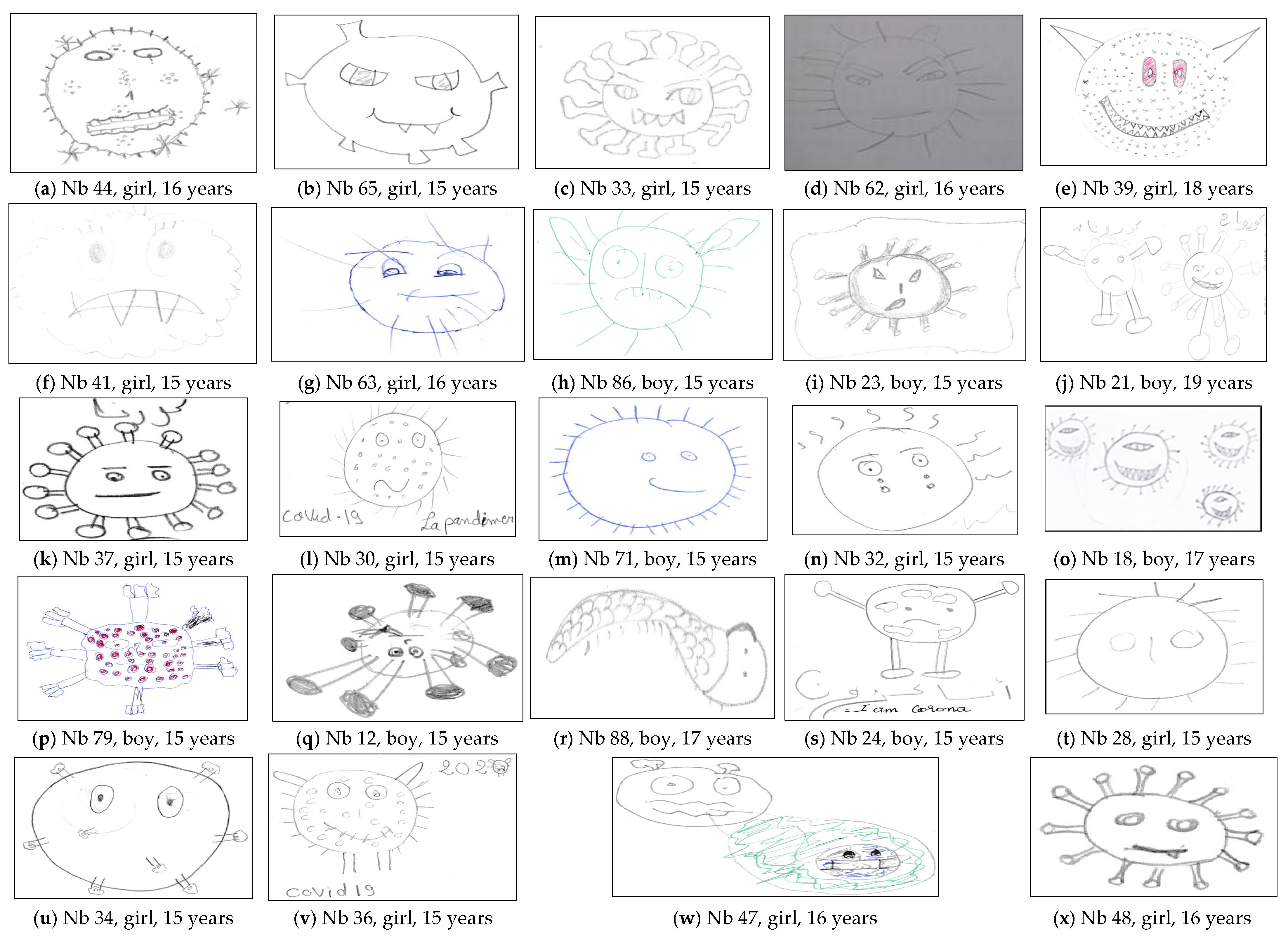

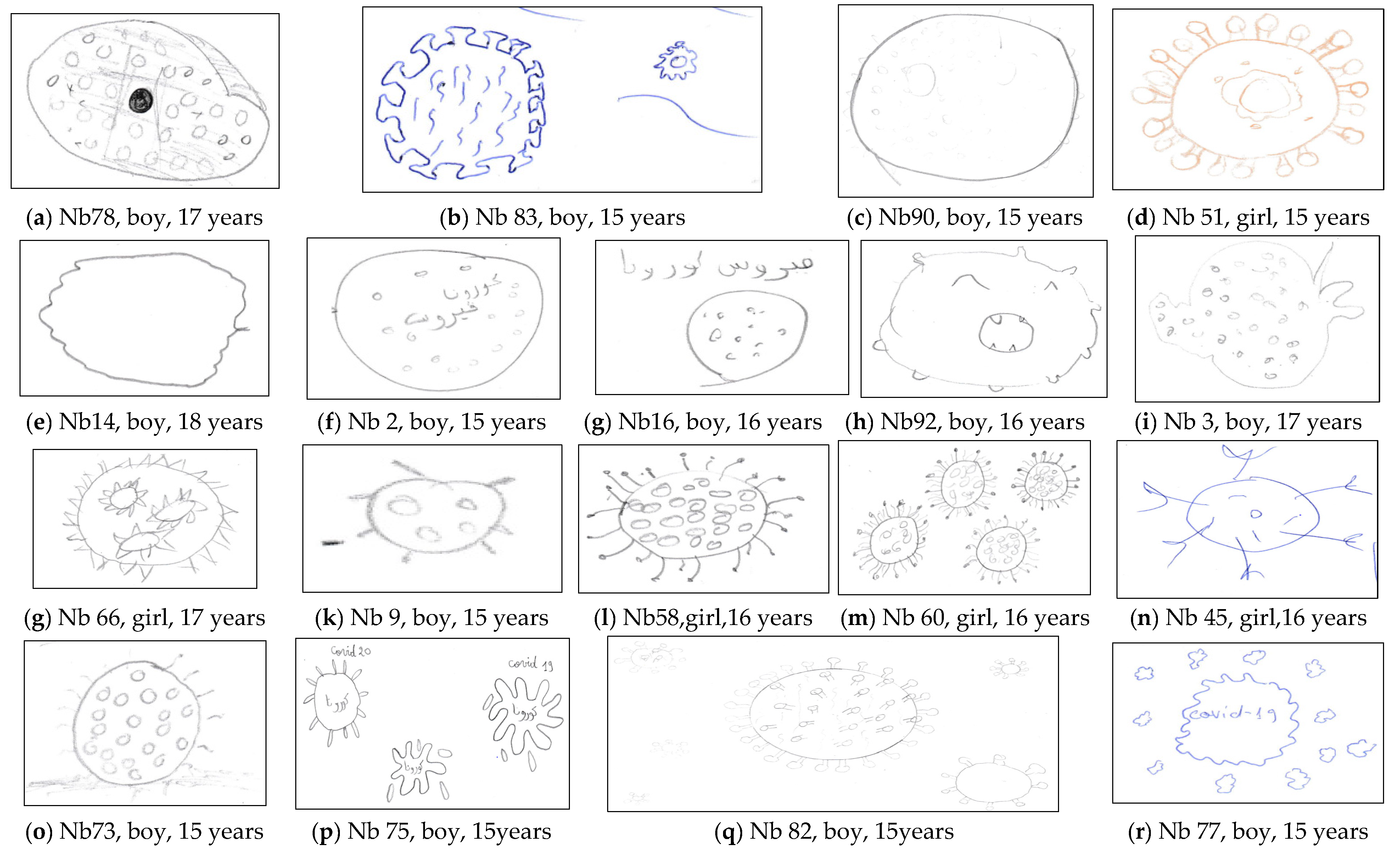
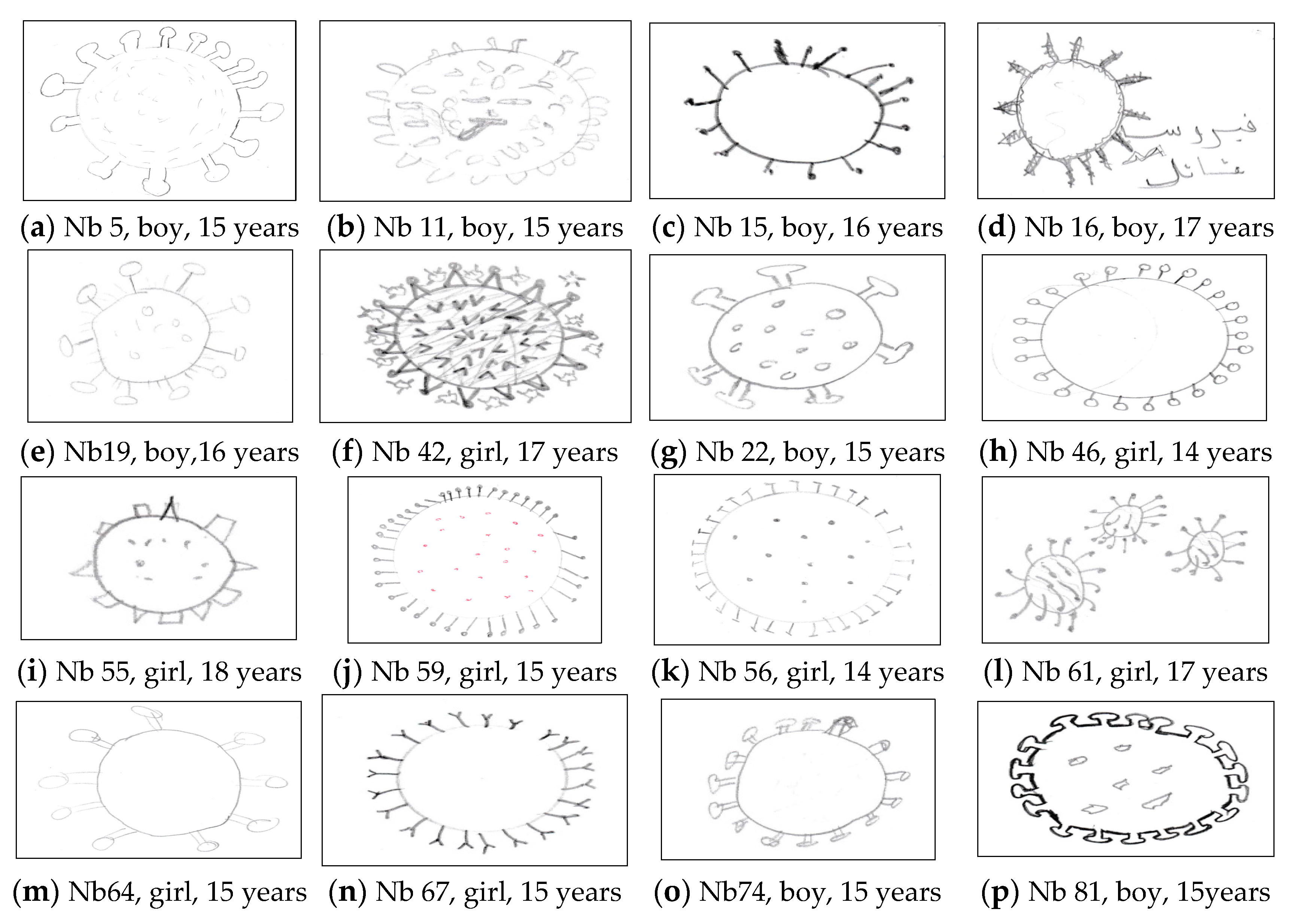

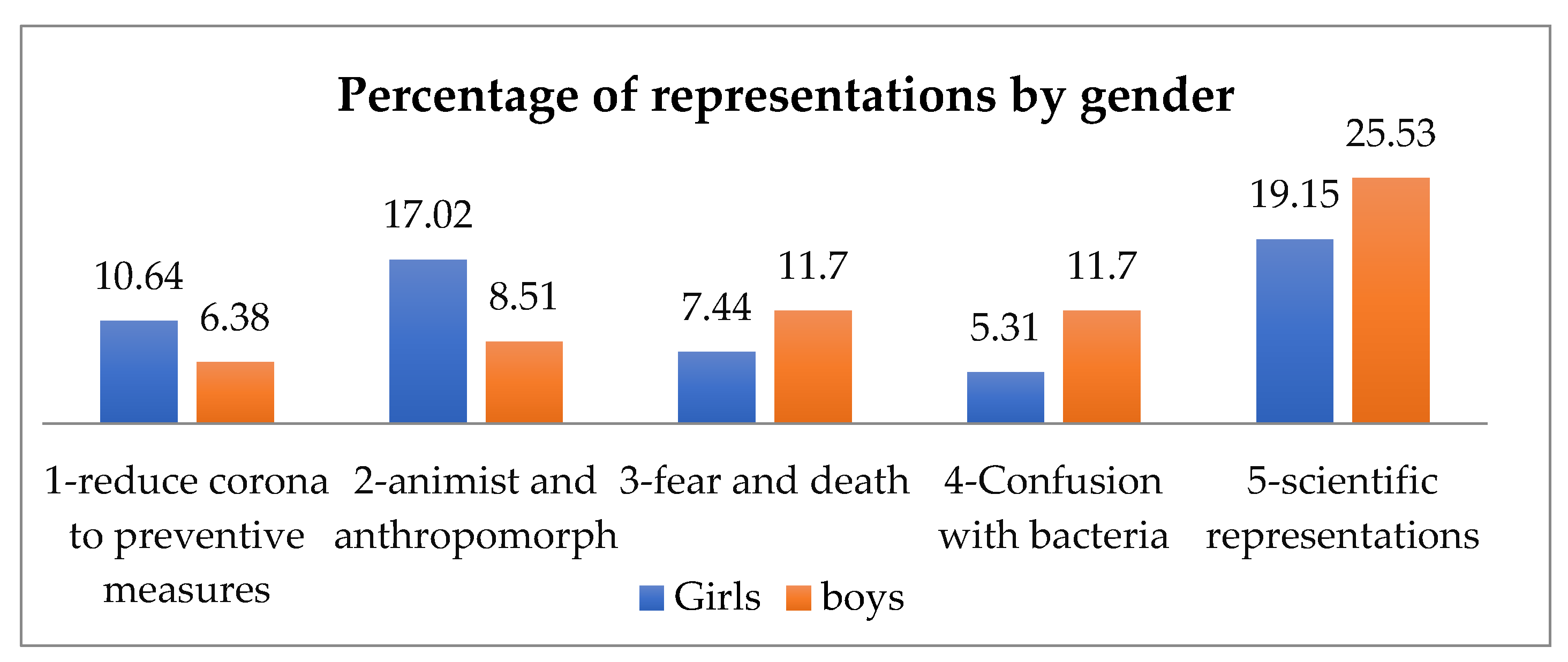
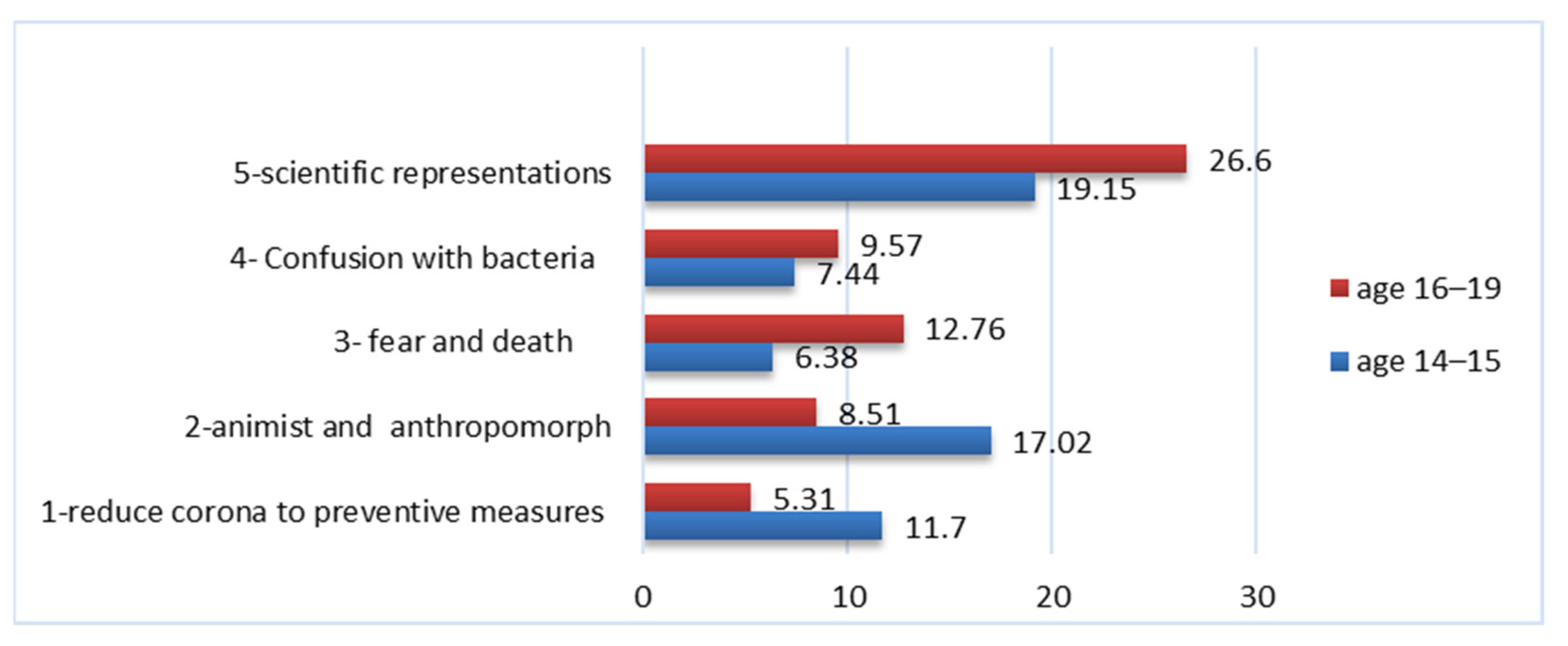
| Schools | Gender | Total | ||||
|---|---|---|---|---|---|---|
| Girls | Boys | |||||
| N | % | n | % | N | % | |
| Imam Malik High School | 19 | 43.18 | 25 | 56.81 | 44 | 46.80 |
| Al Fath High School | 26 | 52 | 24 | 48 | 50 | 53.19 |
| Total | 45 | 47.87 | 49 | 52.12 | 94 | 100 |
| N | Minimum | Maximum | Average | Standard Deviation | |
|---|---|---|---|---|---|
| Age | 94 | 14 | 19 | 15.72 | 0.966 |
| N valid (list) | 94 |
| Symmetric Measeures | ||||
|---|---|---|---|---|
| Measure of Agreement Kappa | Value | Asymptotic Standard Error a | Approximate T b | Approximate Significance |
| Reduce Corona to Preventive Measures | 0.895 | 0.059 | 8.724 | 0.000 |
| Animist and Anthropomorphic | 0.894 | 0.052 | 8.716 | 0.000 |
| Fear and Death | 0.903 | 0.055 | 8.797 | 0.000 |
| Confusion with Bacteria & living cells | 0.863 | 0.066 | 8.447 | 0.000 |
| Scientific Representations | 0.936 | 0.036 | 9.092 | 0.000 |
| Kolmogorov–Smirnov a | Shapiro–Wilk | |||||
|---|---|---|---|---|---|---|
| Statistics | f.d | Sig. | Statistics | f.d | Sig. | |
| 1-Reduce coronavirus to preventive measures | 0.504 | 94 | 0.000 | 0.454 | 94 | 0.000 |
| 2-Animist and anthropomorph | 0.465 | 94 | 0.000 | 0.543 | 94 | 0.000 |
| 3-Fear and death | 0.494 | 94 | 0.000 | 0.480 | 94 | 0.000 |
| 4-Confusion with bacteria | 0.504 | 94 | 0.000 | 0.454 | 94 | 0.000 |
| 5-Scientific representations | 0.368 | 94 | 0.000 | 0.632 | 94 | 0.000 |
| Category | Drawing Descriptions | % | Representations | |
|---|---|---|---|---|
| 1 | Drawings that translate COVID-19 into behaviors related to preventive measures, such as:
| 11.25 | Representations that reduce COVID-19 to preventive measures | |
| 2 |
| 29.6 | Animistic and anthropomorphic representations that give COVID-19 a dynamic quality “hero” | |
| 3 |
| 15.50 | Representations that link COVID-19 to fear and death | |
| 4 |
| 10.50 | Confusing COVID-19 with bacteria and living cells | |
| 5 |
| identical | 25.40 | Scientific representations |
| different | 7.75 | |||
| Statistic Test a | |||||
|---|---|---|---|---|---|
| 1-Reduce Corona to Preventive Measures | 2-Animist and Anthropomorphic | 3-Fear and Death | 4-Confusion with Bacteria | 5-Scientific Representations | |
| Mann–Whitney U | 1002.000 | 904.000 | 1019.000 | 971.000 | 984.000 |
| Wilcoxon W | 2178.000 | 2080.000 | 2100.000 | 2052.000 | 2065.000 |
| Z | −1.185 | −2.003 | −0.943 | −1.545 | −1.054 |
| Asymp. Sig. (2-tailed) | 0.236 | 0.045 | 0.346 | 0.122 | 0.292 |
| Statistic Test a | |||||
|---|---|---|---|---|---|
| 1-Reduce Corona to Preventive Measures | 2-Animist and Anthropomorphic | 3-Fear and Death | 4-Confusion with Bacteria | 5-Scientific Representations | |
| Mann–Whitney U | 963.500 | 916.500 | 963.500 | 1057.500 | 963.500 |
| Wilcoxon W | 2091.500 | 2044.500 | 2091.500 | 2185.500 | 2091.500 |
| Z | −1.638 | −1.882 | −1.564 | −0.546 | −1.238 |
| Asymp. Sig. (2-tailed) | 0.101 | 0.060 | 0.118 | 0.585 | 0.216 |
Publisher’s Note: MDPI stays neutral with regard to jurisdictional claims in published maps and institutional affiliations. |
© 2022 by the authors. Licensee MDPI, Basel, Switzerland. This article is an open access article distributed under the terms and conditions of the Creative Commons Attribution (CC BY) license (https://creativecommons.org/licenses/by/4.0/).
Share and Cite
Maskour, L.; El Batri, B.; Oubit, S.M.; Jeronen, E.; Agorram, B.; Bouali, R. Analysis of Drawings on Representations of COVID-19 among Senior High School Students: Case of the Dakhla-Oued Eddahab Region, Morocco. Educ. Sci. 2022, 12, 892. https://doi.org/10.3390/educsci12120892
Maskour L, El Batri B, Oubit SM, Jeronen E, Agorram B, Bouali R. Analysis of Drawings on Representations of COVID-19 among Senior High School Students: Case of the Dakhla-Oued Eddahab Region, Morocco. Education Sciences. 2022; 12(12):892. https://doi.org/10.3390/educsci12120892
Chicago/Turabian StyleMaskour, Lhoussaine, Bouchta El Batri, Sidi Mohamed Oubit, Eila Jeronen, Boujemaa Agorram, and Rahma Bouali. 2022. "Analysis of Drawings on Representations of COVID-19 among Senior High School Students: Case of the Dakhla-Oued Eddahab Region, Morocco" Education Sciences 12, no. 12: 892. https://doi.org/10.3390/educsci12120892
APA StyleMaskour, L., El Batri, B., Oubit, S. M., Jeronen, E., Agorram, B., & Bouali, R. (2022). Analysis of Drawings on Representations of COVID-19 among Senior High School Students: Case of the Dakhla-Oued Eddahab Region, Morocco. Education Sciences, 12(12), 892. https://doi.org/10.3390/educsci12120892










